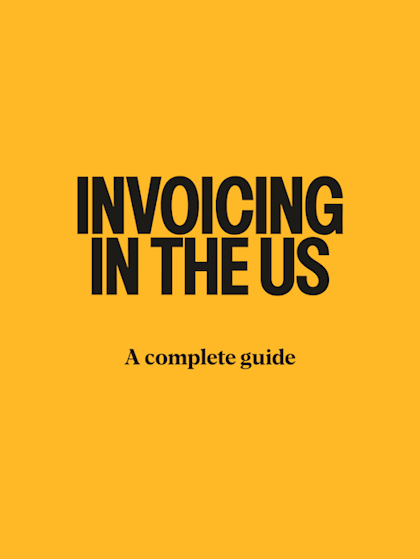
Last editedSep 20243 min read
An explanation of the most common forms of receiving invoice payments, along with the pros and cons of each option.
All businesses want to get paid as quickly as possible. While issuing invoices promptly is the first step, making paying easy for customers is also essential to good invoice management. However, perhaps the best way to eliminate late invoice payments is to use a 'pull' payment method, such as ACH Debit, which puts the business in control of payment collection.
There are a number of popular invoice payment methods available to business owners, and we consider the pros and cons of each below.
Invoice payment by checks and cash
Despite the increased popularity of digital payments, some customers still prefer paying with checks or cash.
Advantages
This approach has the merit of largely avoiding transaction fees.
Disadvantages
However, payments in hard currency or by check involve more admin, are inflexible, and can be slow and unpredictable.
Accepting cash or checks creates manual accounting admin, as you must log each payment. Late payers can also go unnoticed without automated notifications of overdue invoices. As a result, cash flow may be impacted.
Paying invoices by standing orders
Customers instruct their bank to pay you a fixed sum via standing order. The customer must set up the standing order themselves through their bank. The customer specifies the amount and dates of the transfer when they set it up and can cancel via their bank at any time, and you will not be notified.
Advantages
A standing order is a cheap or often free option for businesses to take payments. Also, once set up, the instruction will run until it is cancelled, so there is a degree of automation possible.
Disadvantages
Standing orders lack flexibility and involve much manual paperwork.
Any change to the amount, date or frequency of payments will invalidate the instruction, meaning the customer will need to set up a new standing order.
They also increase the risk of late payments as it is down to the customer to set up, with no notifications if invoices aren't settled as expected.
Credit and debit card invoice payments
Card payments are commonplace and easy for your customers to use. They supply their card number online, by phone or in person, which is then linked to their bank account by card networks and settlement banks to take the funds requested.
Advantages
Credit and debit cards are a convenient way of making one-off transactions or subscribing to regular payments.
Disadvantages
Accepting payment by credit and debit card can be expensive for merchants as costs are high for both individual transactions and for monthly fees. Failed payments are also reasonably common due to rejected, expired or lost cards.
Furthermore, merchants have very little visibility of payment status. With card payments, you won’t know a payment has failed until you check your bank account. Cards also create significant manual admin, both for regular accounting and because of chasing failed payments.
Invoicing payments via ACH Debit
ACH Debit - also known as bank debit or Direct Debit - is an automated 'pull' payment controlled by the merchant, with lots of flexibility. It represents the best choice for businesses who want to have their invoices paid on time.
Advantages
ACH Debit can help you automate payment collection. Customers authorize you to pull agreed payments from their bank account on due dates set by you. As a 'pull' payment, ACH Debit ensures that you get paid on time, eliminating late payments almost entirely!
Once a customer gives authorization, you can vary the frequency and amount of payment as required without having to seek further permission from your customer.
ACH Debit carries a much lower cost per transaction for the merchant, and payment success rates are very high. It's a flexible way to take payments, with minimal hassle involved.
Disadvantages
ACH Debit is not suitable for businesses that need instant payment, payments can take between 3 - 5 days to be processed. Apart from these timings, there are no real disadvantages to ACH Debit. It is a cheap, reliable and secure way to get paid on time and avoid late payments and high levels of manual admin.
Get paid on time, pay lower transaction fees & reduce financial admin by automating payment collection with GoCardless and ACH Debit.
Bank transfer
Bank transfers come in two major types - wire transfer and ACH transfer. Each is essentially a service which enables payments directly from one bank account into another. Learn more in our guide to wire transfers vs. ACH transfers.
Advantages
While bank transfer is a payment method commonly used for regular payments in some industries, it can also work for one-off transactions.
Bank transfers are popular due to low transaction fees and failure rates.
Disadvantages
Like a number of the methods discussed, bank transfers carry the risk companies will not be alerted if payments fail. Again, the crux of the issue is who controls the payment method.
Bank transfers are manual 'push' payments; therefore, the customer decides exactly when to pay and how much. Putting the customer in control of invoice payments encourages late payments and ultimately impacts cash flow.
We can help
GoCardless provides an automated ACH Debit service that allows merchants to control payment collection, eliminates late payments and is more affordable than card payments.
Furthermore, automation reduces the level of manual admin. With a user-friendly merchant dashboard and over 200 accounting software integrations, merchants can set up payments in just a few clicks.
With no contract or upfront commitment required, it is quick and easy to start getting paid on time with GoCardless today!
Learn more about GoCardless and ACH Debit.
Case Study: How Diaper Stork saves time and money with ACH and GoCardless
Using GoCardless has enabled Diaper Stork to reduce payment costs, with the company now paying 2% less per transaction than cards for every customer that chooses ACH debit.
On top of the monetary savings, automating financial admin and eliminating late payments has saved the business 2 - 3 hours a month in accounting time, allowing them to focus on improving the customer experience.
Learn more about how GoCardless can save you time and money on payment collection.
